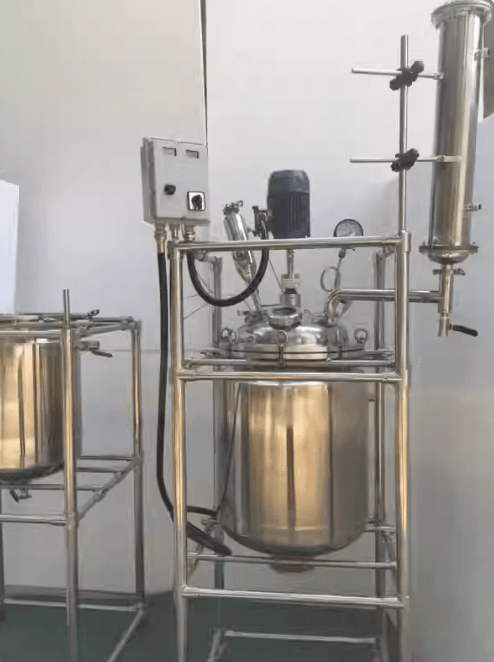Industrial Applications of Double-Layer Stainless Steel Reactors: A Comprehensive Overview
Double-layer stainless steel reactors are increasingly becoming essential in various industrial applications. Their ability to provide precise temperature control and enhance safety makes them indispensable in the chemical, pharmaceutical, and food processing industries. In this article, we will explore the industrial applications of double-layer stainless steel reactors, highlighting their versatility and the advantages they bring to multiple sectors.
These reactors are designed with two layers of stainless steel: an outer layer that can be heated or cooled and an inner layer that directly contains the reaction mixture. This unique design allows for temperature regulation, enhancing the efficiency and safety of various industrial processes. Let’s dive into the industrial applications of double-layer stainless steel reactors and explore how these reactors are used in different sectors.

Key Features of Double-Layer Stainless Steel Reactors
The industrial applications of double-layer stainless steel reactors are vast, with the key feature being their dual-layer structure. This design is crucial for controlling temperature, pressure, and the overall reaction environment. Some of the main advantages include:
- Thermal Control: In industrial applications of double-layer stainless steel reactors, the outer layer acts as a thermal jacket. It can be either heated or cooled, allowing for precise temperature regulation within the inner chamber. This ensures that the reaction mixture maintains optimal conditions, enhancing both the speed and efficiency of the process.
- Safety: The dual-layer construction increases safety in industrial environments. By controlling the temperature of the outer layer, the inner chamber remains stable, minimizing the risk of dangerous overheating or reactions. This is especially important in industries that handle volatile substances or need to maintain strict temperature conditions.
- Durability: Stainless steel is known for its resistance to corrosion and high durability, making it ideal for industrial applications of double-layer stainless steel reactors. Whether exposed to high temperatures, pressures, or aggressive chemicals, stainless steel reactors provide long-lasting performance with minimal maintenance.
- Efficiency: By maintaining consistent conditions and reducing the chances of unwanted side reactions, these reactors improve process efficiency. This is a crucial factor in industrial applications of double-layer stainless steel reactors, where maximizing production yields and minimizing waste are essential for profitability.
Industrial Applications of Double-Layer Stainless Steel Reactors in the Chemical Industry
In the chemical industry, industrial applications of double-layer stainless steel reactors are indispensable. These reactors are employed in processes such as polymerization, chemical synthesis, and the production of specialty chemicals. The reactors’ ability to maintain consistent thermal conditions ensures that reactions proceed smoothly, with controlled rates and minimal byproducts.
For instance, in the production of specialty polymers, these reactors are used to maintain precise temperature and pressure conditions, ensuring high-quality output. The dual-layer structure allows for the precise heating or cooling required for optimal polymerization rates, enhancing the consistency and yield of the final product.
Moreover, in large-scale chemical manufacturing, industrial applications of double-layer stainless steel reactors contribute to cost savings by improving reaction rates, reducing energy consumption, and minimizing the need for additional processing steps.
Pharmaceutical Industry and the Role of Double-Layer Stainless Steel Reactors
The pharmaceutical industry is another area where industrial applications of double-layer stainless steel reactors are crucial. Pharmaceutical manufacturing processes require highly controlled environments to ensure the quality and consistency of active pharmaceutical ingredients (APIs) and finished products. The precise temperature control offered by double-layer stainless steel reactors ensures that sensitive compounds are not degraded during production.
For example, in the synthesis of APIs, these reactors are used to maintain the exact temperature and pressure required for each reaction step. This minimizes the risk of side reactions and ensures that the final product is of the highest quality.
Environmental Benefits of Double-Layer Stainless Steel Reactors
In addition to their industrial applications, double-layer stainless steel reactors also offer environmental benefits. The efficiency of these reactors reduces energy consumption, as the precise temperature control prevents excessive heating or cooling. This makes them an environmentally friendly option for industries looking to reduce their carbon footprint.
Moreover, the durability and longevity of stainless steel reactors contribute to sustainability. Their ability to withstand harsh conditions means fewer replacements are needed, leading to reduced waste and lower overall material consumption.
Industrial Applications of Double-Layer Stainless Steel Reactors: A Look Ahead
The future of industrial applications of double-layer stainless steel reactors is bright. As industries continue to demand higher efficiency, safety, and sustainability, these reactors will play an even more important role. Their ability to handle a wide range of chemical processes, from sensitive pharmaceutical manufacturing to large-scale chemical production, ensures that they will remain at the forefront of industrial innovation.
For businesses seeking high-quality reactors, solutions like those offered by EquilRxnLab provide advanced technology tailored to meet the needs of modern industrial applications.
To explore further details on double-layer stainless steel reactors and their applications, visit our product page at EquilRxnLab’s Double-Layer Reactor.
Stay updated on the latest developments in the industry by following us on Instagram.



